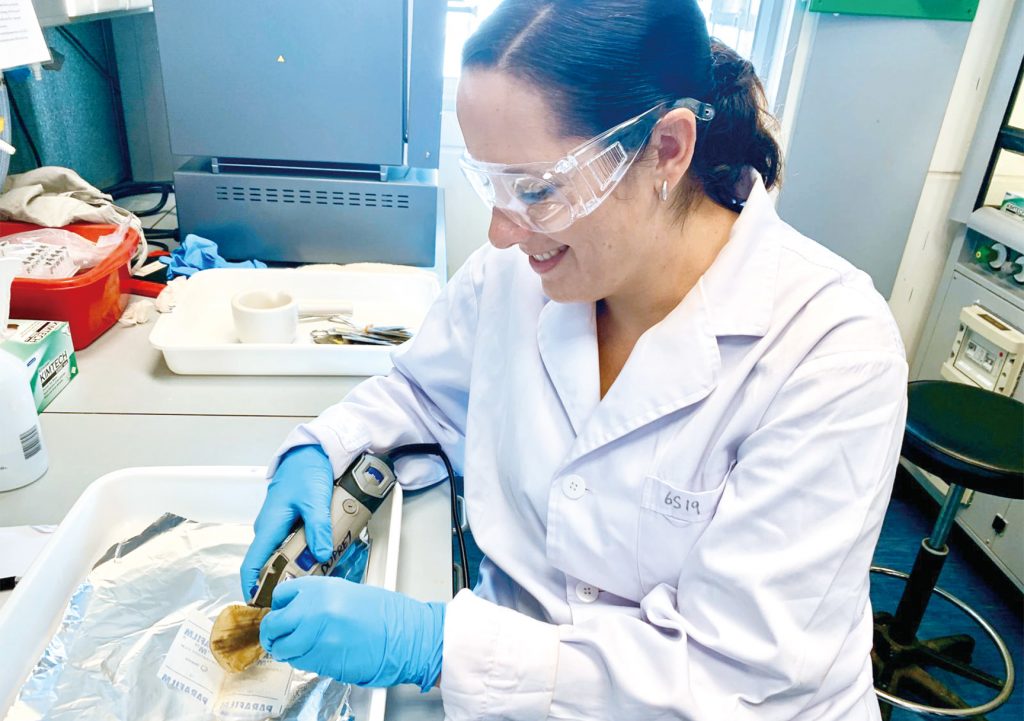May 2024 | Volume 25 No. 2
Origin of the Species
Listen to this article:
The idea to use genomic analysis came from Professor Timothy Bonebrake of HKU’s School of Biological Sciences, and Professor Thomas Smith of the University of California, Los Angeles (UCLA). While working together studying climate change responses of butterflies in Cameroon in 2013, they discovered a mutual intrigue with the connection between Asia and Africa regarding the pangolin trade, and this led to the idea of building an international database to determine where the scales had originated.
The first step – and it was a big one – was to create the reference database on pangolin, a task that would require much time and major collaboration with scholars, researchers and experts spanning four continents.
“We worked with a range of local collaborators in Africa who had access to samples of pangolins in their distribution. This is critical for reference,” said Professor Bonebrake. “It took us many years to complete and was logistically very challenging – we needed many permits from lots of different countries.
“Tom Smith and I worked together early in the project to design the study and supervise the activities. Dr Jen Tinsman, also of UCLA, joined the project soon after that and led the effort – she coordinated all activities and oversaw the execution of the research with Tom and myself. This was very much an integrated team effort.”
At the Hong Kong end of the equation, they worked with partners including the Agriculture, Fisheries and Conservation Department and Kadoorie Farm and Botanic Garden, who had samples from seizures of illegally-traded pangolin scales. Two PhD students in the School of Biological Sciences at HKU, Taneisha Barrett and Tracey-Leigh Prigge, then worked in the lab to extract DNA from the scales and prepare for sequencing.
“The preservation of these samples – some of which date back to 2012 – was brilliant scientifically and I’m glad they did this,” said Professor Bonebrake. “Once we have each of these [reference samples and seizure samples] and have sequenced the genomic information then we can find matches and see where samples seized in Hong Kong most likely originated.”

PhD student Tracey-Leigh Prigge drilling powder from pangolin scales to be used for DNA extractions and/or stable isotope analysis.
Beyond pangolin
It is very much an ongoing project, and one that could be expanded beyond pangolin. “We’re still trying to find samples to sequence,” he said. “The more samples we have the finer the resolution of the trade that we can characterise. The team would love to do this for other species: we did a similar study for tokay geckos a couple of years ago, but we lack a strong reference database like the one we now have for white-bellied pangolin. Hopefully in the future this will change because there are many species traded for which we need more information on spatial and temporal dynamics.”
Other researchers have expressed interest in applying the approach to different seizure samples and systems. “It has been a very positive response and I’m optimistic that the work will encourage follow-up study of pangolins and other overexploited species.”
The genomic analysis so far has revealed that there is little correspondence between the transit locations and the sources of pangolins themselves, suggesting high levels of movement of scales prior to shipping to Asia.
“I suspect this pattern is a consequence of a number of factors, including the avoidance of detection from law enforcement,” said Professor Bonebrake. “It could also have something to do with logistics planning. Scales may be easiest to transport overseas in large quantities which then requires the amassing of scales in specific locations.”
The researchers hope the work, which has been published in the journal Science, will ultimately open more doors to redirecting international resources to the protection of pangolins, and to authorities to tracking down traffickers. While it is too early to say if this will happen, they are already expanding their investigations.
“We need to understand more fully all of the actors involved in the trade of pangolins,” said Professor Bonebrake. “Our research characterises key transit pathways between the origin of pangolins and the location of seizures. Now we need to see if the pangolin populations in these source locations can be better protected and conserved. We also need to understand more about patterns of demand for pangolin products – how does the demand for these products in traditional medicine drive the trade and is the level of demand changing over time?
“A new species of pangolin was recently ‘discovered’ from a seizure in Hong Kong. This is an Asian species but we don’t even know where it lives. So, there is still a lot more we need to investigate regarding the trade of pangolins to ensure their effective conservation. And, unfortunately, global wildlife trade is affecting a huge diversity of species. My hope is that increased technological advancements and international cooperation, as implemented in this research, will give us options for reversing species declines.”
Our research characterises key transit pathways between the origin of pangolins and the location of seizures. Now we need to see if the pangolin populations in these source locations can be better protected and conserved.

Professor Timothy Bonebrake

